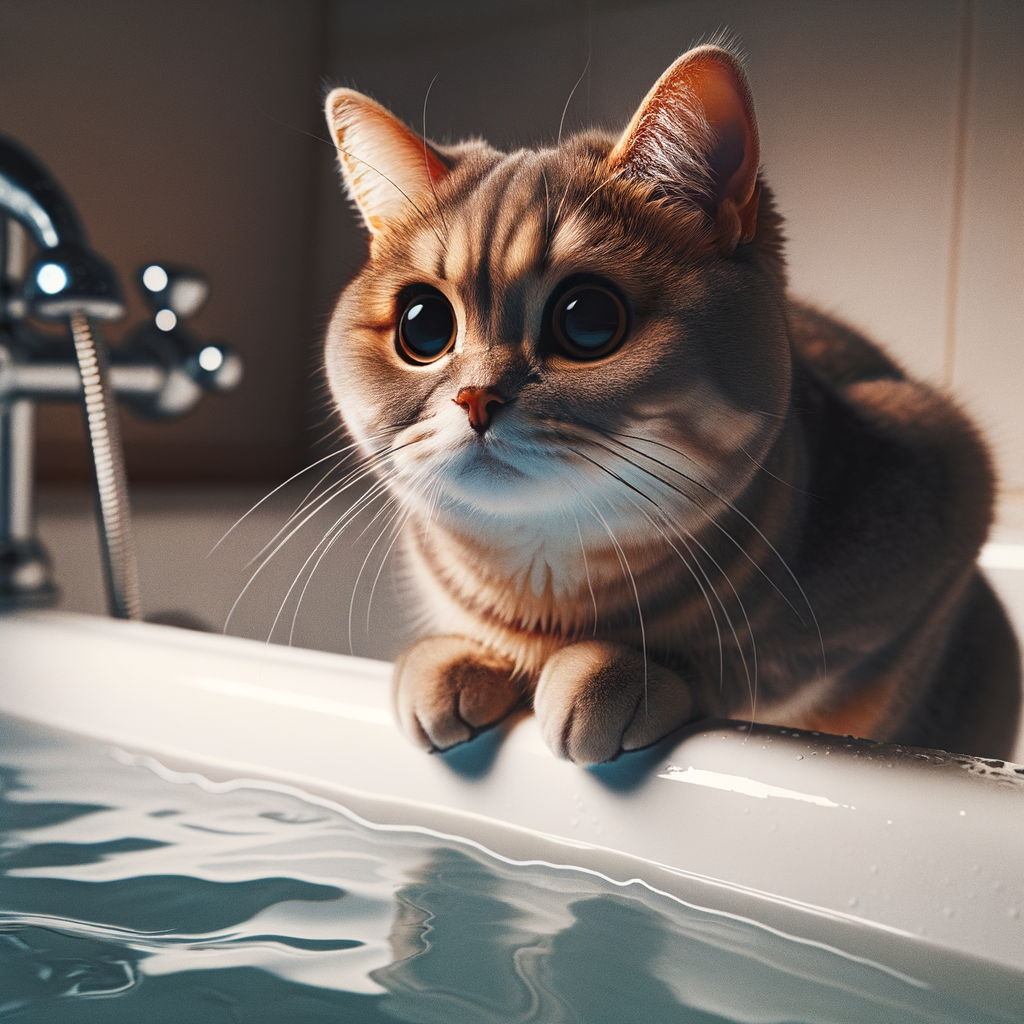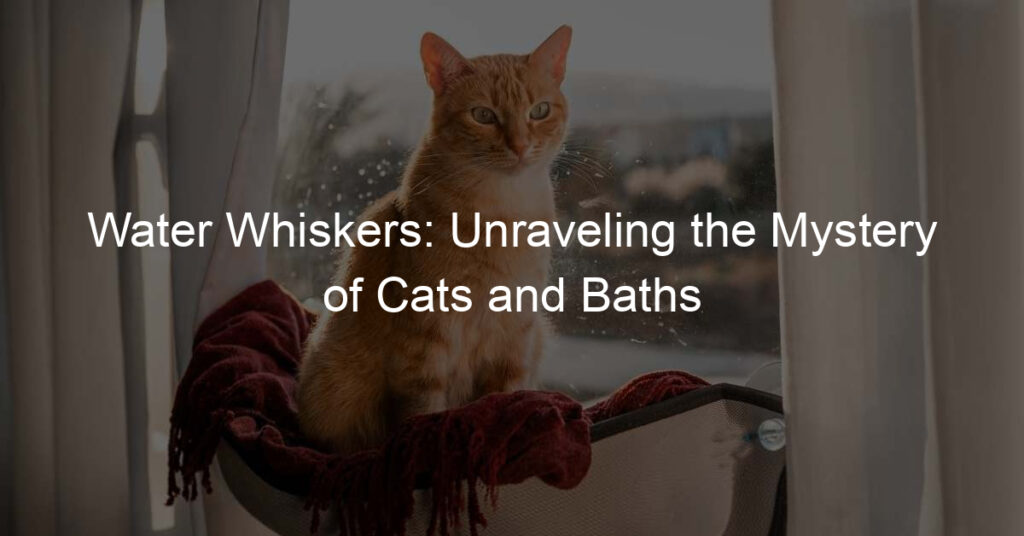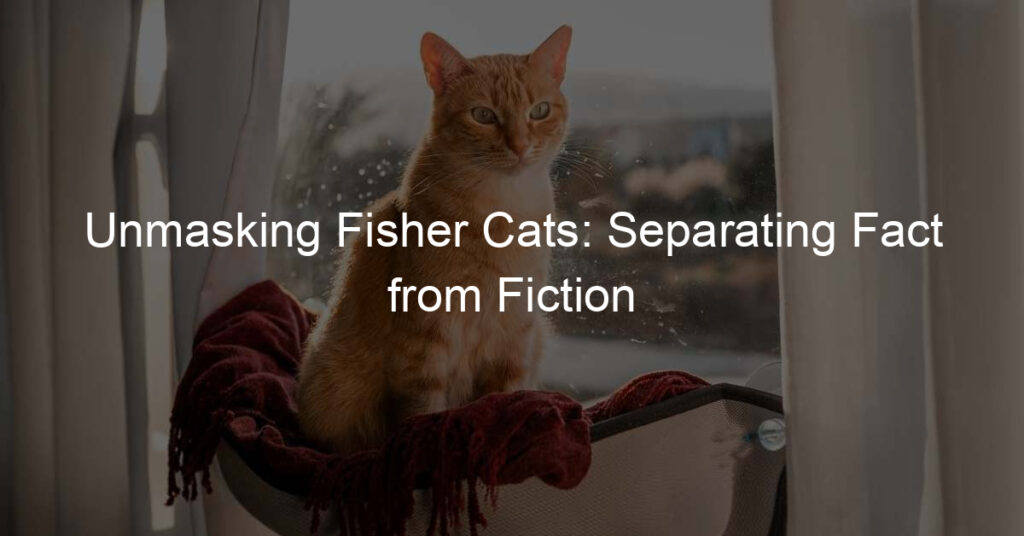
Introduction: Cats and Water
Have you ever wondered why your feline friend seems to have an aversion to water? Cats, unlike their canine counterparts, are known for their dislike of water. This blog post aims to explore the intriguing relationship between cats and water, and understand why most cats seem to have an aversion to it.
- Exploring the intriguing relationship between cats and water
- Understanding the common feline aversion to water
Cats are fascinating creatures with unique behaviors and preferences. One of the most intriguing aspects of feline behavior is their relationship with water. While some cats seem to enjoy playing with water, the majority appear to dislike it. This aversion is not just limited to bathing but extends to even minor interactions with water.
Did you know that cats are one of the few animals that prefer to stay dry? According to a study by the American Veterinary Medical Association, about 70% of cats showed signs of stress when exposed to water. This could be due to their fur’s structure, which unlike dogs, does not repel water effectively, making them feel uncomfortable when wet.
Understanding why cats dislike water can be traced back to their ancestors. Cats evolved in dry and arid regions, where they had little to no interaction with large bodies of water. As a result, they never developed the need to swim or interact with water like other animals.
Another reason could be the sensitivity of a cat’s skin. Cats have a higher body temperature than humans, and getting wet can make them feel cold. Moreover, the sensation of water on their fur can be uncomfortable as it weighs them down and takes a long time to dry.
However, not all cats dislike water. Certain breeds like the Maine Coon or the Turkish Van are known to enjoy swimming. It’s important to remember that each cat is unique and may have different reactions to water.
Feline Bathing Habits
Understanding the bathing habits of our feline friends can be quite intriguing. Let’s delve into why cats seem to have an aversion to water from a biological perspective.
Why Cats Hate Water: A Biological Perspective
Many cat owners have observed that their furry friends often show a strong dislike for water. This behavior is not just a random quirk; it’s deeply rooted in their biology and evolution. Let’s explore this in more detail.
- The evolution of cats’ fear of water
- How a cat’s coat reacts to water
Cats are descendants of feline species that lived in dry arid regions. These ancestors had little to no contact with large bodies of water, which is why they didn’t need to adapt to swimming or being in water. This evolutionary trait has been passed down to our domestic cats, making them naturally wary of water.
Another biological reason why cats dislike water is due to their unique fur. A cat’s coat is designed to keep them warm and insulated. When it gets wet, it becomes heavy and takes a long time to dry, leaving the cat feeling uncomfortable and cold. This is why cats prefer to stay dry and clean themselves using their tongues.
In conclusion, the aversion cats have towards water is not a mere preference, but a characteristic that has been ingrained in them through evolution and their unique biological makeup. Understanding this can help us better care for our feline friends and respect their natural instincts.
Understanding Cats’ Relationship with Water
Water and cats have a complex relationship. While we often think of cats as being afraid of water, the truth is a bit more nuanced. Let’s delve into understanding this unique relationship.
- Exploring Feline Water Behavior
- Case Study: Observing Cats’ Reactions to Water in a Controlled Environment
Cats, unlike dogs, are not naturally inclined to play in water. This behavior can be traced back to their ancestors, who were desert dwellers. Despite this, some cats do enjoy water. It’s all about individual preferences and experiences. For instance, a cat that has had positive experiences with water from a young age may grow to enjoy it.
It’s also worth noting that cats are meticulous groomers. They spend a significant portion of their day grooming themselves, using their tongues to clean their fur. This behavior keeps their coat in top condition, reducing the need for baths.
In a recent study, a group of cats was observed in a controlled environment with water. The cats were introduced to water gradually, starting with a shallow dish and gradually increasing the depth. The reactions varied significantly.
| Cat | Reaction to Water |
|---|---|
| Cat 1 | Initially hesitant, but eventually entered the water |
| Cat 2 | Refused to go near the water |
| Cat 3 | Played in the water happily |
As you can see, the reactions were diverse, reinforcing the idea that cats’ relationship with water is individual. It’s crucial to understand your cat’s unique relationship with water and respect it. Never force a cat into water, as it can cause stress and fear.
In conclusion, while it’s common to think that all cats hate water, the reality is more complex. Some cats may enjoy water, while others may not. Understanding your cat’s unique relationship with water can help you provide the best care for your feline friend.
Bathing Cats: A Comprehensive Guide
When it comes to bathing cats, there are a few essential steps to ensure a stress-free experience for both you and your feline friend. In this guide, we will focus on how to prepare your cat for a bath.
Preparing Your Cat for a Bath
Before you even think about turning on the tap, there are a couple of crucial steps you need to take to ensure your cat is ready for bath time.
- Steps to reduce cats’ fear of water before bath time
- Choosing the right products for bathing cats
It’s no secret that most cats aren’t fans of water. However, there are ways to help reduce their fear. Start by introducing your cat to water gradually. This could be as simple as letting them play with a few drops of water on a waterproof surface. Over time, you can increase the amount of water they are exposed to. Always remember to reward your cat with treats and praise for their bravery.
Not all shampoos and conditioners are suitable for cats. It’s important to choose products specifically designed for feline use. Look for gentle, hypoallergenic products that won’t irritate your cat’s skin or eyes. Also, consider investing in a non-slip mat for the bottom of the bath or sink to prevent your cat from slipping and sliding around.
Preparing your cat for a bath is a crucial step in the bathing process. By taking the time to reduce their fear of water and choosing the right products, you can help ensure a positive experience for both you and your cat.
The Bathing Process
Now that we have prepared our feline friend for a bath, let’s dive into the actual process. Here is a step-by-step guide on how to properly bathe a cat, followed by some key takeaways and tips for a stress-free bath.
- Step 1: Fill the Tub
Begin by filling the tub or sink with about three to four inches of warm water. Make sure the water is not too hot or too cold. A good rule of thumb is to aim for a temperature that would be comfortable for a baby. - Step 2: Slowly Introduce the Cat to Water
Slowly lower your cat into the water while gently speaking to them in a calm and reassuring voice. Remember, this can be a scary experience for them, so patience is key. - Step 3: Apply Cat-Friendly Shampoo
Apply a small amount of cat-friendly shampoo and gently massage it into your cat’s fur. Avoid the face and ears to prevent irritation. - Step 4: Rinse Thoroughly
Rinse your cat thoroughly with a cup or handheld shower head. Ensure all the shampoo is washed out to prevent skin irritation. - Step 5: Dry Your Cat
Once the bath is over, wrap your cat in a warm towel and gently pat them dry. Avoid rubbing as it can cause their fur to mat.
Now, let’s move on to some key takeaways and tips for a stress-free bath:
- Preparation is Key: Always have everything you need within arm’s reach before starting the bath. This includes towels, shampoo, and a cup for rinsing.
- Patience is Essential: Remember, your cat may not be used to bathing, so it’s important to be patient and calm throughout the process.
- Positive Reinforcement: Reward your cat after the bath with their favorite treat or some extra cuddle time. This can help them associate bath time with positive experiences.
By following these steps and tips, you can ensure a smooth and stress-free bathing experience for both you and your feline friend.
Cats and Water Phobia: Addressing the Fear
It’s a well-known fact that most cats don’t like water. But did you know that some cats actually have a phobia of water? This fear can make simple tasks like bathing your cat a real challenge. In this section, we will explore the signs of water phobia in cats and understand why they might have this fear.
Identifying Signs of Water Phobia in Cats
Recognizing water phobia in your cat is the first step towards helping them overcome their fear. Here are some common symptoms:
- Recognizing symptoms of water phobia in felines
- Understanding the causes of cats’ aversion to water
Cats with water phobia may show signs of extreme distress when they come into contact with water. They might hiss, scratch, or try to escape. They may also show signs of anxiety, like shaking or hiding, even when they just hear the sound of running water.
There are several reasons why a cat might develop a fear of water. Some cats may have had a traumatic experience with water in the past, like being forced into a bath or falling into a body of water. Others may simply dislike the feeling of being wet. It’s also possible that the fear is instinctual, as many wild cats avoid water to keep their fur dry and maintain body heat.
Understanding your cat’s fear of water is the first step in helping them overcome it. In the next section, we will discuss some practical steps you can take to help your cat become more comfortable with water.
Helping Your Cat Overcome Water Phobia
It’s not uncommon for cats to have a fear of water. But don’t worry, there are practical steps you can take to help your feline friend become more comfortable with water. Let’s explore these steps and also discuss when it might be necessary to seek professional help.
- Practical steps to help your cat become more comfortable with water
- Professional help: When to consult a vet or a cat behaviorist
Firstly, it’s important to introduce water to your cat gradually. Start by letting your cat explore a dry tub. Once they’re comfortable, add a small amount of water. Over time, you can increase the water level. Always ensure the water is at a comfortable temperature for your cat.
Secondly, make bath time fun for your cat. Use toys that float in water to create a positive association. Treats can also be a great reward after a successful bath.
Lastly, remember to be patient. Overcoming fear takes time. Never force your cat into water as it can increase their fear.
If your cat’s fear of water is severe, it may be time to consult a professional. A vet can rule out any medical issues that might be causing the fear. For instance, some cats may associate water with a painful medical procedure.
A cat behaviorist, on the other hand, can provide specialized techniques to help your cat overcome their fear. They can also provide insight into why your cat might be afraid of water.
In conclusion, helping your cat overcome water phobia is a process that requires patience and understanding. But with the right approach, your cat can learn to tolerate, if not enjoy, water.
Conclusion: Feline Water Interactions
As we draw our discussion to a close, it’s crucial to revisit and summarize the key points we’ve covered about our feline friends and their relationship with water. This understanding will help us better care for our cats and respect their unique boundaries.
- Recap of Cats’ Relationship with Water
- The Importance of Understanding and Respecting Your Cat’s Boundaries with Water
Contrary to popular belief, not all cats are afraid of water. Some breeds, like the Maine Coon and the Turkish Van, are known for their love of water. However, most domestic cats prefer to stay dry. This is due to their ancestors, who were desert dwellers and had little to no interaction with large bodies of water. Cats also have a highly efficient grooming system that involves licking their fur, which makes bathing unnecessary in most cases.
Understanding your cat’s relationship with water is essential for their well-being. Forcing a cat into water can cause stress and fear, potentially damaging your relationship with your pet. Always introduce water gradually and in a positive manner. If your cat needs a bath, use warm water and cat-friendly products. Remember, patience and respect for your cat’s boundaries are key to a successful and stress-free bathing experience.
In conclusion, while cats’ relationship with water can vary, it’s important to understand and respect their boundaries. By doing so, we can ensure a happy and healthy life for our feline companions.








